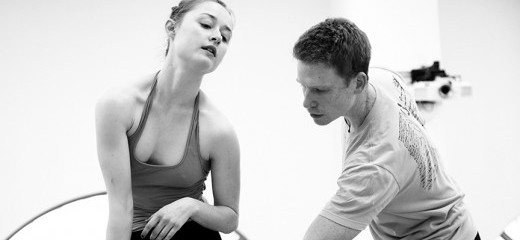
Photo: Bill Hebert
The Simplicity of X: BalletX and Organizational Sustainability
by Eleanor Goudie-Averill
I began my interview with Christine Cox, co-founder, co-Artistic and Executive Director of Philadelphia’s BalletX, with a complicated question: How did she, along with Matthew Neenan, create a sustainable organization that is distinctive and appealing to the public?
My impulse to interview Cox, and to write about the financial and commercial success (or at least stability) of BalletX, came from seeing them succeed not only in terms of their full season of repertoire, well-placed advertisements and increased ticket sales, but also in terms of artistry.
I saw BalletX perform for the first time while visiting Philadelphia from Lewisburg, PA, where I was teaching ballet at Bucknell University as a sabbatical cover. I am a fan of contemporary ballet, which I associate with dance dresses, worn-in canvas shoes, lyrically extended extremities punctuated with darting piqués and intricate partnering. BalletX, I felt, represented a type of contemporary ballet found more often in Europe than in America—likely because of the ballet/modern split embedded in our cultural perception of concert dance.
To many of us, ballet represents convention and we, rightfully, see modern dance (and its evolving aesthetic in the post/post-post modern era), as a break from ballet. The contemporary work that I saw at my first BalletX concert in 2008 was ballet that seemed to have evolved organically out of its own history as a form.
After moving to Philadelphia in 2009 and seeing approximately one BalletX show each year since, I have been most impressed with the progression of the technique and artistry of their dancers. An organization that invests in dancers enough to allow them to stay on, excel artistically, and seem to flourish, must be doing something right.
In my interview with Cox, she stated that the dancers are “#1 in the [company’s] vision” and spoke to the company’s investment in training dancers with a strong ballet background and pushing the dancers they hire to become the best athletes they can be. Cox is interested in dancers who want to better themselves, and said that she understands and appreciates (as someone who danced hard for a long time with a big company—the Pennsylvania Ballet) the sacrifices dancers have to make to be fully invested in a company. BalletX’s dancers will work a 27-week season next year, with a goal for 35 weeks in three years, for what Cox described as a “competitive salary.”
Good dancers, though the primary ingredients in dance making, cannot account for the financial success of a company. Going into the interview with Cox, I felt as though I knew the basic elements of BalletX’s financial success: a home theater, a strong and committed board, staff members, and artistic directors that present themselves as professionals (many funders do seem to respond well to artists who understand business casual). Cox agreed that these elements were all important, especially the relationship with the Wilma Theater, which she said “professionalized” the company and gave them a home.
Cox also spoke extensively about marketing, design, maintaining a consistent image for the company and building a good relationship with their graphic designer. Cox and Neenan broke from Phrenic New Ballet in 2004 (a company with Amanda Miller and Tobin Rothlein that had a more multimedia focus) to “simply be a company that’s creating new work,” and renamed themselves BalletX: “The freedom of the X gave us a platform to imagine that anything was possible.”
The first thing the new BalletX did was work with their designer on the perfect logo. They wanted a “crisp, clean” look and, after one attempt that made them look “like they were from Texas” (as one of the presenters at APAP noted), found a logo to match the kind of work they planned to put forward: “athletic, pushing boundaries.” The rest of their marketing, which can be seen in poster form all over Center City and in the advertisements on the sides of buses, is in line with the logo’s “professional and clear” aesthetic.
Cox is a businesswoman, and made it clear in our conversation that she makes an effort to “step back and understand marketing.” She and Neenan, who creates three works a year on the company and who serves as the primary choreographer, make a solid artistic team and together have branded the company in a way that is legible to the Center City community members who make up their audience. Though it may seem like all business, Cox said they are “married as a family. We are a family, and that’s what we want our audience to know that they are part of.”
“We want to be a company that’s creating new work… and not just making work that the audience loves,” she said. “I want to like it, to be blown away… to see choices that surprise us as dance-makers. If the choreography is looking similar—I have been seeing a lot of socks and pedestrian clothing—we go back to ballet. What does contemporary ballet look like? We want see what’s working and not working, continuing to investigate to provide a wide perspective on the dancers’ incredible talents.”
By Eleanor Goudie-Averill
July 8, 2014

